This September marks the twentieth anniversary of Batman: The Animated Series, and the birth of the shared DC animated universe that would eventually expand to present one of the most comprehensive and thorough explorations of a comic book mythology in any medium. To celebrate, we’re going back into the past and looking at some classic episodes.
I suppose we should start at the beginning. It’s hard to believe that it has been twenty years since Batman: The Animated Series first appeared on television. I think that it’s had a fairly massive impact – both on superheroes in animation, but also back in the original source material. Although On Leather Wings was not the first episode of the show to be broadcast (it was beaten by The Cat and the Claw, Part I), it was the first produced. While the episode itself falls quite short of greatness, it’s interesting to note just how many of the show’s successful ingredients were clearly present from the outset.
Part of what is interesting about On Leather Wings – and what sets it apart from the first episodes of the shows that would follow – is just how little is actually introduced in the episode. On Leather Wings assumes at least a working knowledge of Batman and his world. In a way, it reflects Tim Burton’s Batman, which relegated the iconic origin to a flashback in the middle of the film. Here, the first glimpse we get of Batman is in full costume, in the cave, doing Batman stuff while Afred gets all snarky towards him. The scene assumes we know about the Bat-cave, that Batman is a hero and that Bruce Wayne is Batman. (Alfred makes reference to cancelling Bruce’s date with “… Bambi, was it, sir?”)
It’s an interesting approach and one that makes the continued dependence of superhero movies on character origins seem a little ridiculous. After all, if a half-hour cartoon can dump us in at the deep end, there’s no reason for The Amazing Spider-Manto recap the iconic web-crawler’s origin story. It is telling, though, that both Superman and the Justice League would get their own origin stories to launch their series. Meanwhile, Batman – coming off a massive Tim Burton film – was presumed to be so widely known that no introduction was strictly necessary.
On Leather Wings appears to be set quite early in Batman’s career. The police are still hunting him as a vigilante, with Harvey Bullock running a gung-ho squad of macho tactical goons causing wanton destruction across Gotham to arrest the Bat. The Bat-signal doesn’t seem to exist yet. In one of the nicer touches, Harvey Dent is still… well, Harvey Dent. I like that Batman: The Animated Series took the time to introduce Harvey as a character before his inevitable transformation in Two-Face. Sure, he is only around for about two episodes, but it suggests a loose continuity, and underscores the idea that Harvey was a vital part of Gotham’s social fabric.
That said, On Leather Wingsdoes seem to go out of its way to introduce certain concepts to the show. The shots of Batman driving the Batmobile seem to last a bit longer than they should, especially since one imagines that the Batmobile is the most obvious item in Batman’s arsenal of tricks. There’s also a very weird early fixation on Batman’s grappling hook, a sequence that feels consciously inserted to set up Batman’s use of the device at the climax of the story. Again, you don’t get more basic than Batman’s grappling hook, so the way the episode seems to consciously point to the devices introduction seems a little strange.
On the other hand, the episode does a great job defining what it is that Batman does. We wouldn’t really get to know this version of the character for a few more episodes, but On Leather Wings does a wonderfully efficient job of outlining Batman’s methodology – how he approaches crime. Rather than merely treating Batman as a punchin’ and kickin’ action hero, the episode goes out of its way to show us Batman as a detective with fancy gadgets, and even finds a way for Bruce to facilitate the investigation using his own financial connections.
Although there’s very little distinctive about this Batman’s personality yet – his back story isn’t mentioned, and the story avoids going into the details of how or why he does what he does – we see hints of the wonderful impression that Kevin Conroy will make as Bruce and Batman. There’s a short, but wonderful, sequence where the Batcave receives a call from Doctor March for Bruce. Batman, in his outfit, picks it up and answers… in Bruce Wayne’s voice. It’s only seeing the two elements of the character so effectively juxtaposed that you truly realise how wonderfully Conroy differentiated the two. Fantastic stuff. And, of course, the best was yet to come.
The only real problem with the episode if the plot. It’s about as generic as it comes. And Man-Bat is a fairly generic character. The series would go on to do excellent work with second- and third-tier Batman villains (and even Man-Bat’s follow-up episode was quite decent) but here Kirk Langstrom feels a bit superfluous. The crew seemed to want a simplistic villain who mirrored the hero in a simplistic way, and Man-Bat provides that. He also probably serves as an affectionate shout-out to Neal Adams, the artist who created the character and redefined Batman in the seventies.
Still, Langstrom comes across as positively one-dimensional, if only because the episode makes it quite clear that he did this to himself. Sure, the end result might have been a little off, but when he talks about how he had the courage to experiment on himself, it makes Langstrom sound like a rather stereotypical villain, a wannabe ubermensch who just happens to look like a Bat. It’s interesting, because “transformation” villains like the Lizard or even the Hulk tend to be the ones that draw a great deal of sympathy, if only because they can’t be held accountable for their actions. Despite only having about a dozen lines, Langstrom comes across as a character who must have heavily suspected what he was doing.
That said, the episode does manage to milk some good of the character, and the characters discuss “the virtue of Chiroptera”, or bats to you and me. There’s a wonderful bit of irony as an irate scientist protests to Bruce, “They’re survivors, Mister Wayne, not pests! You should understand that!” Of course Bruce understands that. Still, it’s not quite enough to sustain an episode, and it struggles for time with the subplot about Bullock hunting down Batman. The plotting all feels a bit rushed, despite efficiently introducing the series itself.
After all, that’s where On Leather Wings distinguishes itself. Plot-wise, it’s solidly middle-of-the-road. It’s reasonably well pieced together, has a few nice character moments, and it makes sense in the end. However, the episode only really becomes something truly special when you consider that it was the first episode produced. Often, there’s a great deal of tweaking as a show develops and grows – to the point where the first half of the first season often looks like a completely different show. Barring the extended establishing shots, On Leather Wings is put together with so much confidence and skill that it seems almost natural.
All the ingredients that defined and distinguished Batman: The Animated Series are present from almost the opening shot. There’s that wonderful film noir aesthetic, as the show evokes the German expressionist cinema movement that clearly inspired Bob Kane. There are some beautiful silhouetted shots of the creature on the prowl. Like its lead, the series makes excellent use of shadows. The show efficiently establishes its weird thirties aesthetic, with impossible objects like police blimps co-existing alongside old-fashioned cars, black-and-white televisions and more modern technology.
Shirley Walker’s score sounds wonderfully crisp here. She’d do a wonderful job expanding on Danny Elfman’s definitive Batman soundscape over the course of the show, but even here it still sounds impressive. Andrea Romano has put together a fabulous cast. Even ignoring Kevin Conroy for a moment, the guest cast is wonderful. Rene Auberjones plays a tiny role, while Marc Signer pops up as Kirk Langstrom. Both are actors who had worked on on-going live-action shows, so securing them was quite the coup. On Leather Wings does an exceptional job establishing the potential of the show.
I think that’s what makes On Leather Wings work so well. It’s not one of the best episodes of the show. It can’t quite measure up to the best of the adventures to come, as it is too conventionally plotted and a tad too generic in places. However, it demonstrates the remarkable potential of the series, while hinting at the things to come.
Filed under: Television | Tagged: alfred pennyworth, batman, Blimp, Bruce, bruce wayne, danny elfman, Dark Knight Rises, Shirley Walker |















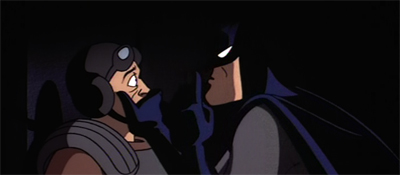
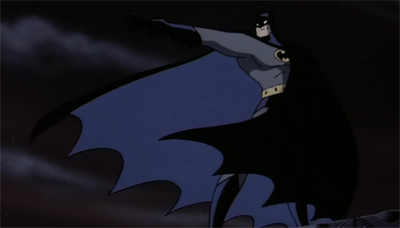

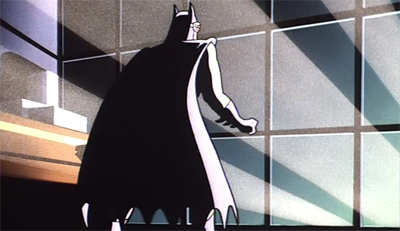
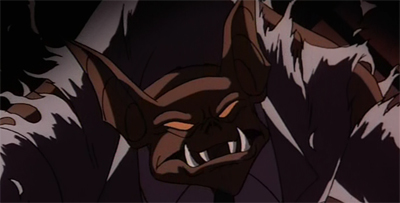
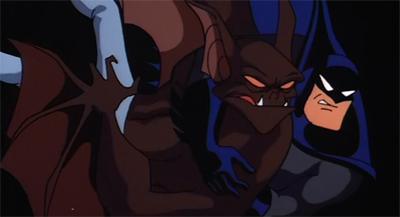
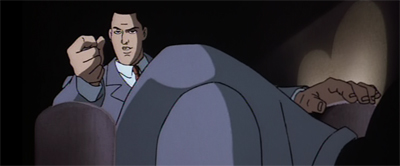





Watched this really recently and completely agree with what you’ve put here. I actually had to check this was the first episode because it did so little “background and origin.” I was disappointed with the villain they used to start the series and the ending felt “easy” but its a testiment to the show that its so well produced, you really want more from the stories, almost forgetting they are still “kids cartoons.”
I actually think that Nothing to Fear works much better as a pilot, because it introduces Batman’s central conflicts, his psychological issues, and it establishes the villains as a mirror for him. Man-Bat is obviously a nice visual counterpoint to Batman, but he’s very tough to write as a twisted reflection of Batman, and the episode doesn’t do it.
Thats why I think its very easy to fall into the trap of forgetting this was designed as a kids show and that Pilots and setting up the series aren’t all that important